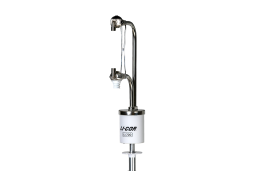Variables, data, and diagnostics
Normally, the LI-720 reports flux results every 30 minutes with averages of biological and meteorological variables. It can be configured to provide the results in as short as five minutes or as long as one hour in five minute increments. In addition, high-speed raw data can be recorded at 10 Hz.
Flux results are reported to LI-COR Cloud via an IoE Module, stored in the IoE Module SD card, or logged to an external data logger. When enabled, raw data (10 Hz) are continually output over the RS-232 serial wires, and can be recorded to the IoE Module SD card or an external data logger.
Time stamp
When used with an IoE Module, the LI-720 does not use its internal clock. Instead, it enters an external trigger mode upon recieving the first trigger from the IoE Module via SDI-12. In this mode, the IoE Module controls the timing of flux intervals. The IoE Module clock is automatically aligned with time stamps from GPS satellites.
When not connected to an IoE Module or data logger that can trigger a measurement period, the LI-720 disciplines its internal clock to the GPS time stamp from its own GPS receiver. If the LI-720 recieves one trigger but no follow up trigger, it will self-trigger a new measurement period after 36,000 samples have been recorded (1 hour of raw data). This is a fallback; a properly configured data logger will issue the trigger command on a schedule of 5 to 60 minutes (30 minutes recommended).
All time stamps are logged in UTC with no offset. You can apply an offset for the local time zone manually on the IoE module or you can choose a time zone when you download data from LI-COR Cloud. The offset applied to the time stamp is indicated in the data file.
Note: When setting a time zone on the IoE Module, use Standard Time. Do not apply an offset for Daylight Saving time to prevent artificial gaps and overlaps in the time series.
When data from a sensor, such as LI-710 or LI-720, are requested by the IoE Module, data are delivered with time stamp from the IoE Module. Those results are delivered to LI-COR Cloud with the time data intact. LI-COR Cloud will read the time that is included with sensor data, and it uses that information to construct the time series for displayed parameters. When you download data from LI-COR Cloud, you can choose a time zone to be applied to the data. The time stamp will be adjusted by adding or subtracting hours. The offset is indicated in the time field (+0000 is UTC, -0006 is US Central Time, and so on).
Raw data
Raw data are provided at 10 Hz. You can view the data in the CarbonWare app or record it on the IoE Module or an external data logger.
Computed results
Computed results are fluxes over the thirty-minute period and averages of biological and meteorological parameters over the same period. Computed results can be logged to an external data logger (SDI-12), LI-COR Cloud via an IoE Module, or an IoE Module that is not connected to LI-COR Cloud. The parameters delivered are the same.
When retrieved from LI-COR Cloud, the file will be presented as text or a MS Excel spreadsheet. The file name is the date of the dataset. The time stamp is in UTC. If a time zone offset it applied, it is indicated in the data. After extracting the compressed data, you'll see one file for each component that contributed data. You may have one file from the LI-720 and one from the IoE Module. Additional files may be present if other devices are connected to the IoE Module.
